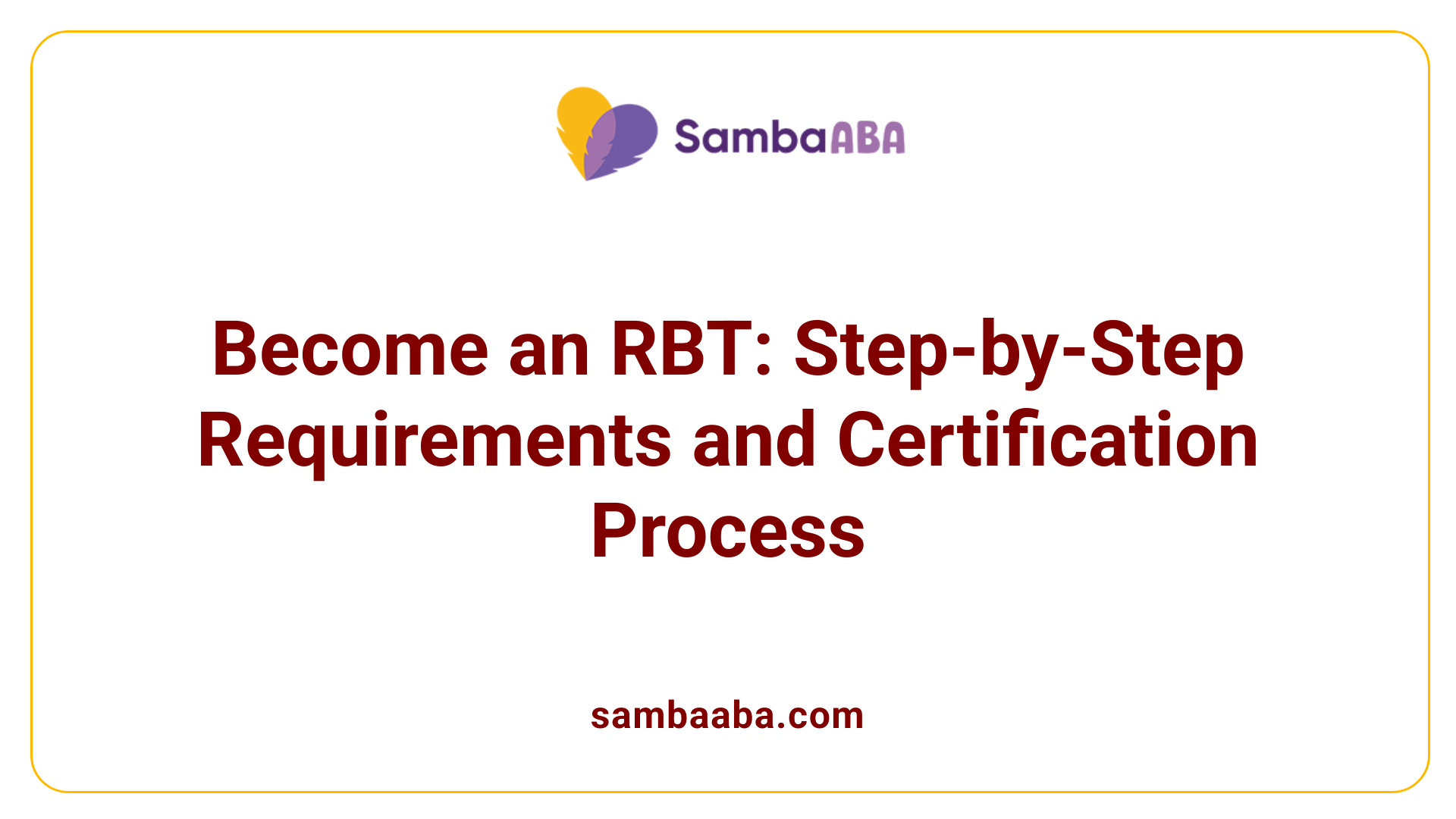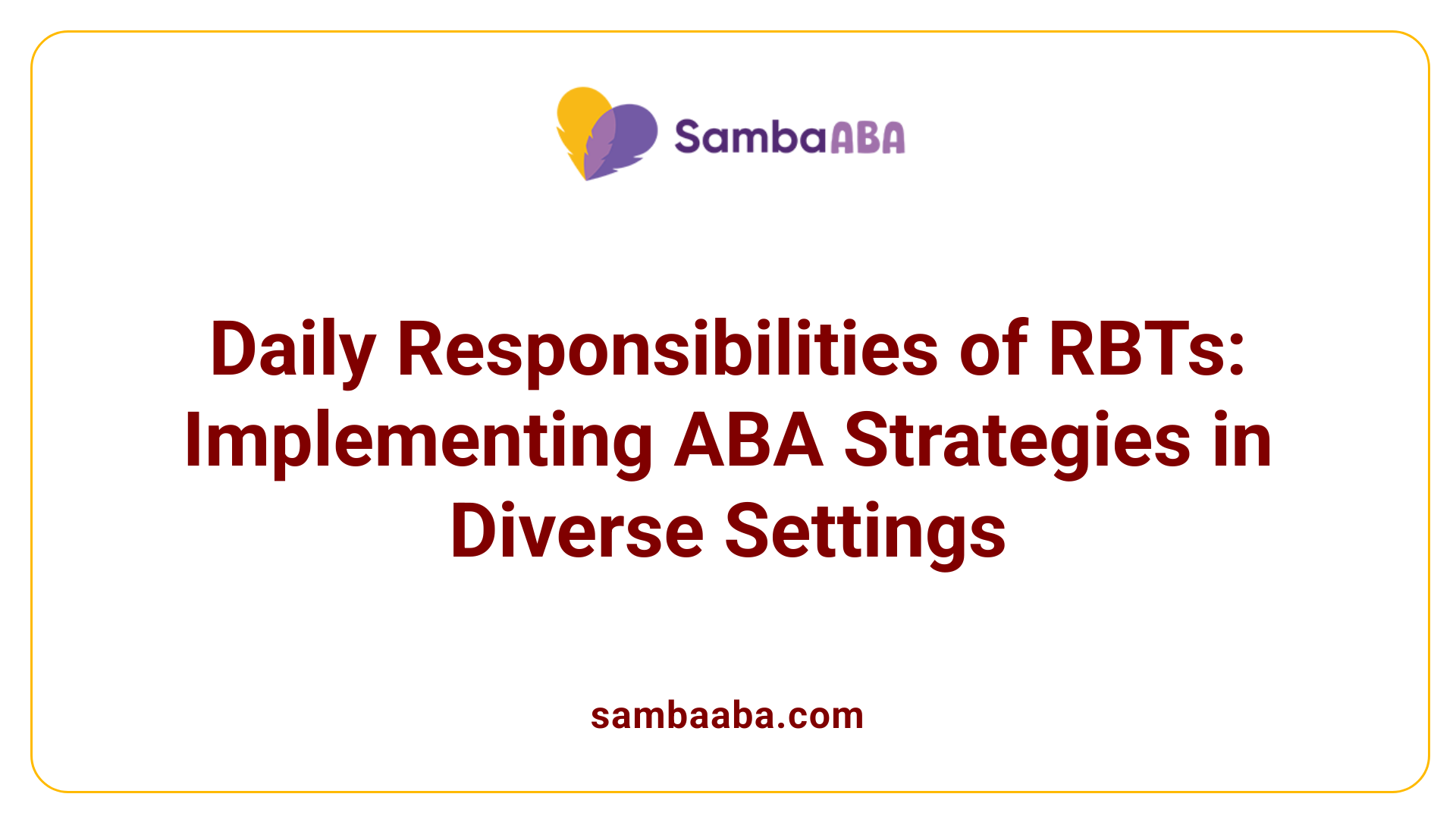Is RBT Certification Worth It?
Unveiling the Value of RBT Certification in Behavioral Health
Understanding the Growing Significance of RBTs in Healthcare
The demand for Registered Behavior Technicians (RBTs) has seen a remarkable increase in recent years amid expanding awareness of autism spectrum disorders and the effectiveness of Applied Behavior Analysis (ABA) therapies. This surge highlights the importance of certification as a credential that not only enhances professional credibility but also opens up diverse employment opportunities in various settings such as clinics, schools, homes, and community centers. With a stable career outlook and a clear pathway for advancement, many professionals are evaluating whether obtaining RBT certification is a worthwhile investment for their future.
Requirements and Process to Become an RBT

What are the requirements and process to become a Registered Behavior Technician (RBT)?
Becoming an RBT involves several important steps, starting with meeting basic eligibility criteria. Candidates must be at least 18 years old, have completed high school or possess a GED, and pass a background check to ensure suitability for working with vulnerable populations.
The next step is undertaking a 40-hour training program that aligns with the Behavior Analyst Certification Board (BACB) guidelines. This training covers fundamental ABA principles, ethical practices, and intervention strategies. Notably, programs like the one offered by UTSA PaCE provide comprehensive online training, supported by experienced instructors and additional resources, ensuring candidates are well-prepared.
After completing the training, individuals are required to conduct a Competency Assessment within 90 days. This assessment, overseen by a BACB-certified supervisor, evaluates practical skills and knowledge in implementing ABA techniques. Successful completion of this assessment is crucial before proceeding.
Subsequently, applicants must submit an application to the BACB, along with necessary documentation such as proof of training completion, the competency assessment, and a background check. Once approved, candidates are eligible to sit for the RBT Certification Exam.
The exam is structured as a 90-minute multiple-choice test covering six key content areas: Measurement, Assessment, Skill Acquisition, Behavior Reduction, Documentation and Reporting, and Professional Conduct. Passing the exam certifies individuals as RBTs.
Maintaining certification is an ongoing process. RBTs must complete annual renewal procedures that include ongoing supervision, ethical compliance, and continuing education requirements. Ensuring adherence to BACB standards helps preserve the credential’s national recognition and professional validity.
This structured pathway guarantees that RBTs are well-equipped to assist in applying ABA strategies effectively, ultimately supporting improvements in their clients' behaviors and overall well-being.
Benefits of Obtaining RBT Certification
What are the benefits of obtaining RBT certification?
Getting certified as a Registered Behavior Technician (RBT) opens many doors in the healthcare and therapy fields. One of the main advantages is improved professional credibility. This certification is recognized nationwide by the Behavior Analyst Certification Board (BACB), validating your skills and knowledge in applied behavior analysis (ABA).
The RBT credential also boosts employability. With the growing awareness of autism spectrum disorders and the need for intervention services, the demand for well-trained RBTs has surged. This creates a high-demand job market with numerous opportunities across settings like schools, clinics, homes, and community programs.
For those interested in career growth, an RBT certification can act as a stepping stone. It provides a foundation for advancing into roles such as a Board Certified Assistant Behavior Analyst (BCaBA) or a Board Certified Behavior Analyst (BCBA). Many professionals leverage their RBT experience to pursue further education and specialization within ABA.
Financially, RBTs often see competitive salaries. Average earnings in the U.S. hover around $54,000 annually, with entry-level positions starting at about $47,000 and more experienced RBTs earning over $66,000. Additionally, the certification improves job stability and opening doors to higher-paying roles.
Beyond financial and professional benefits, working as an RBT offers the reward of making a meaningful impact. Supporting individuals with autism and developmental disabilities through behavioral interventions fosters significant improvements in their lives. Building strong relationships with clients and their families makes this work deeply fulfilling.
Overall, the RBT certification not only enhances an individual’s credibility and marketability but also aligns with a career dedicated to impactful service. It provides a pathway for ongoing growth, specialization, and higher earning potential, while playing a vital role in improving lives.
| Benefit | Description | Additional Details |
|---|---|---|
| Professional credibility | Recognized credential validating ABA skills | Increases trust from employers and clients |
| Employment opportunities | High demand in various settings | Expanding job market due to rising autism awareness |
| Career progression | Pathway to BCaBA and BCBA roles | Further education and specialization options |
| Salary potential | Competitive salaries | $47,000 to over $66,000 in the US |
| Personal fulfillment | Helping individuals with autism | Building meaningful relationships |
| Work environment | Diverse settings including schools and homes | Offers flexibility and varied experience |
Roles, Responsibilities, and Daily Functions of RBTs

What are the roles and responsibilities of a Registered Behavior Technician (RBT)?
A Registered Behavior Technician (RBT) plays a pivotal role within the field of applied behavior analysis (ABA). Under the supervision of a Board Certified Behavior Analyst (BCBA) or a Board Certified Assistant Behavior Analyst (BCaBA), RBTs are responsible for implementing tailored behavior interventions that promote skill development and reduce problematic behaviors.
Their daily responsibilities include collecting detailed data on client behaviors, which helps in assessing progress and effectiveness of interventions. This data collection involves tracking specific behaviors, recording observations, and summarizing findings to inform ongoing treatment strategies.
Applying evidence-based strategies is central to an RBT's work. They utilize methods such as positive reinforcement, prompting, errorless teaching, and shaping to support clients—mainly individuals on the autism spectrum—across different settings like homes, clinics, schools, and community environments.
Building strong relationships with clients and their families is essential. RBTs often work closely with caregivers to ensure consistent application of behavioral strategies and to facilitate generalization of skills outside of therapy sessions. They also educate family members about intervention plans, providing support and guidance.
The role extends to supporting the work of supervising analysts by maintaining clear, accurate documentation of client progress, communicating effectively within the treatment team, and participating in supervision sessions.
To uphold high standards of care, RBTs must adhere to ethical guidelines set by the BACB, complete ongoing supervision, and participate in continuing education programs.
In addition, RBTs assist in behavioral assessments, help develop skill acquisition plans, and contribute to a collaborative team approach to support positive behavioral and developmental outcomes.
In summary, RBTs are essential frontline providers who implement treatment plans, support clients and families, and work under supervision to promote meaningful behavioral change.
Comparison with Other Behavioral Credentials

How does RBT certification compare with other credentials like BCBA for career development?
The landscape of behavioral health credentials includes several certifications, with Registered Behavior Technician (RBT) and Board Certified Behavior Analyst (BCBA) being among the most recognized. Each serves distinct roles within the field of applied behavior analysis (ABA) and offers different pathways for professional growth.
Differences between RBT and BCBA roles
RBTs are paraprofessionals trained to support behavioral interventions by implementing treatment plans, collecting data, and assisting in habitual behavior management. They work directly with clients such as children with autism or other developmental disabilities under the supervision of a BCBA. In contrast, BCBAs are licensed professionals with graduate-level education, responsible for designing intervention strategies, conducting assessments, and supervising RBTs. Their role involves higher-level decision-making and program oversight.
Educational and experience requirements for each credential
Becoming an RBT requires a high school diploma or GED, completing a 40-hour training program, passing a competency assessment, and a certification exam. Continuous supervision is mandatory. On the other hand, BCBAs must hold a master's degree in behavior analysis or a related field, complete at least 315 hours of ABA coursework, accumulate 1,500-2,000 hours of supervised fieldwork, and pass a comprehensive exam. This extensive educational background reflects the advanced responsibilities BCBAs undertake.
Scope of responsibilities and autonomy
RBTs operate under close supervision. Their autonomy is limited to executing behavior plans, data collection, and reinforcement techniques. They lack independent decision-making authority regarding treatment design. BCBAs, however, have the autonomy to develop evidence-based behavior interventions, interpret assessment data, and supervise RBTs and other team members. Their work involves assessment, program development, and ongoing evaluation.
Salary distinctions and job outlook
The average annual salary for RBTs in the U.S. is approximately $54,000, with entry-level positions starting around $47,000 and experienced RBTs earning over $66,000. The job outlook for RBTs is positive, with a projected growth rate of 9% from 2021 to 2031, driven by increased awareness of autism spectrum disorder and the demand for intervention services.
BCBAs tend to earn significantly higher, with salaries often exceeding $80,000, depending on location and experience. The demand for BCBAs is also soaring, with employment increasing by thousands of jobs over the past decade, forecasted to continue as the need for advanced behavioral services grows.
Career progression pathways and potential for specialization
Starting as an RBT can lead to advanced roles. After gaining experience, RBTs often pursue certification as a BCaBA ( bachelors level) or go on to become BCBAs. These pathways open opportunities for greater autonomy, specialized practice areas such as organizational behavior management, or research positions.
| Credential | Educational Requirement | Supervision & Experience | Responsibilities | Salary Range | Job Outlook |
|---|---|---|---|---|---|
| RBT | High school diploma or GED | 40-hour training, competency assessed, supervised | Implement plans, data collection | $47,000 - $66,000 | 9% growth (2021-2031) |
| BCBA | Master's degree in ABA or related | 315 hours coursework, 1,500-2,000 supervised hours, exam | Develop and oversee programs, assessment | $80,000+ | Rapid growth, 5,852% increase (2010-2021) |
Both credentials are integral to the ABA field, with RBTs representing the foundation for a rewarding career in applied behavior analysis. They offer different levels of responsibility, autonomy, and earning potential, fitting various professional goals.
Is RBT Certification a Worthwhile Investment?

What are the career prospects, job security, and earning potential for RBTs?
Registered Behavior Technicians (RBTs) have a promising career outlook with increasing demand across various settings like clinics, schools, and homes. The annual salary for RBTs averages around $54,000, with entry-level positions starting at approximately $47,000 and experienced professionals earning over $66,000. Job security is strong due to the rising awareness of autism spectrum disorders and the recognized importance of Applied Behavior Analysis (ABA) therapy.
This demand creates a favorable environment for employment stability and potential career progression, especially when combined with further certifications such as BCaBA or BCBA.
How is the demand for RBTs and what is the forecasted growth?
The psychology and behavioral health fields are experiencing significant growth. The job outlook for RBTs is expected to expand by about 9% from 2021 to 2031, reflecting a robust increase in client needs.
In parallel, employment for Board Certified Behavior Analysts (BCBAs) has soared by over 5,852% since 2010, indicating a nationwide recognition of ABA therapy's effectiveness. This growth underscores excellent opportunities for RBTs to secure stable roles and advance their careers.
What are the costs and benefits of the certification process?
Becoming an RBT involves costs such as training fees, exam fees, and renewal expenses, which can vary but generally include mandatory ongoing education and supervision. The initial training requires completing a 40-hour coursework, passing a competency assessment, and successfully passing a 90-minute certification exam.
While there are upfront costs, the certification offers a high return, including credential recognition, increased employability, and salary growth potential. It is a nationally recognized accreditation that many employers value highly.
Are there opportunities for advancement and specialization?
Yes, the RBT role serves as a foundational step toward more advanced positions like BCaBA and BCBA, which require graduate-level education and extensive supervised fieldwork. Successful RBTs often pursue these credentials to take on more complex responsibilities, including assessment, treatment planning, and supervision of other staff.
Specializations within ABA, such as working with specific populations or in particular settings, are also available, providing avenues for further career development.
How flexible are the work environments and what is personal fulfillment like?
RBTs work in various environments including schools, clinics, homes, and community settings. This diversity offers flexibility to match personal preferences and lifestyles.
Many RBTs find their work rewarding due to the direct impact they have on improving clients’ behaviors and quality of life. Building strong relationships with clients and their families adds to personal fulfillment.
| Aspect | Details | Additional Info |
|---|---|---|
| Education Requirements | High school diploma or GED | Minimum eligibility to start certification process |
| Certification Costs | Training fees, exam fees, renewal fees | Ongoing investment for continued certification renewal |
| Job Outlook | +9% growth (2021-2031) | Driven by growing autism diagnoses and public awareness |
| Salary Range | $47,000 to $66,000+ | Varies by experience and location |
| Career Progression | RBT → BCaBA → BCBA | Advancement opportunities in ABA |
| Work Settings | Hospitals, schools, homes, community centers | Flexibility and variety in work environments |
Overall, pursuing RBT certification is a worthwhile investment for individuals interested in behavioral health. It offers a promising career path with ample growth, a chance to make a meaningful difference, and the opportunity to continually enhance professional skills in a thriving field.
Aligning RBT Certification with Personal Career Goals

Should I pursue RBT certification based on my personal career goals?
Deciding whether to pursue RBT certification depends heavily on your professional aspirations within the field of behavior analysis or related domains. If your goal is to work directly with clients, implement behavior intervention plans, and develop foundational skills in applied behavior analysis (ABA), becoming an RBT is a valuable stepping stone.
The certification process is straightforward but requires commitment. You must complete a 40-hour training program, pass a competency assessment conducted under supervision, and then succeed in the RBT Certification Exam. These steps ensure you are prepared to deliver quality ABA services while working under the supervision of a Board Certified Behavior Analyst (BCBA).
Continuous professional development is supported through ongoing supervision and additional training opportunities. The BACB, ABAI, university courses, and conferences provide resources for further education and specialization. These opportunities help RBTs build expertise and progress into more advanced roles.
Holding an RBT credential enhances your credibility and marketability. If your ambition is to deepen your involvement in behavior therapy, an RBT certification aligns well with your goals. It serves as a solid foundation for career advancement, enabling you to pursue higher-level certifications like BCaBA or BCBA.
Overall, if your personal career goals include hands-on client work and developing specialized skills in behavior analysis, obtaining the RBT credential is a strategic move. It not only prepares you for immediate job opportunities but also positions you for future growth in the ABA field.
Assessing personal interest in direct client work
One critical factor is assessing your enthusiasm for direct client interaction. RBTs spend much of their time implementing behavior plans, collecting data, and collaborating with families. If you find these responsibilities fulfilling, becoming an RBT aligns with your interests.
Understanding pathways for career growth in ABA
An RBT role often acts as an entry point into the broader field of ABA. From here, individuals can advance to roles such as BCaBA or BCBA, which require additional education and supervised experience but offer higher salaries and more responsibilities.
Considering further education and certification options
Attaining higher certifications involves further coursework, supervised hours, and examinations. For example, becoming a BCBA requires a master's degree, extensive coursework, and more supervised experience. These pathways provide opportunities for specialization and leadership in the field.
Balancing certification costs and benefits against career aspirations
While costs include training fees, exam fees, and renewal fees, the long-term benefits often outweigh these expenses. Salary data shows RBTs earn around $54,000 annually on average, with experienced professionals earning over $66,000. The job outlook remains positive, with steady growth projected over the next decade.
Steps for integrating RBT credentials into long-term plans
To incorporate RBT certification into your career strategy:
| Step | Action | Details |
|---|---|---|
| 1 | Self-assessment | Evaluate your interest in direct client work and long-term goals |
| 2 | Research | Explore training programs like UTSA PaCE and supervision requirements |
| 3 | Enroll | Complete the 40-hour training within the required timeframe |
| 4 | Complete assessment | Under supervision, demonstrate practical skills |
| 5 | Apply | Submit application, documents, and pass the exam |
| 6 | Plan for growth | Use certification as a foundation for further certifications or advanced roles |
Overall, aligning the RBT credential with your personal and professional goals is a strategic move that can open the door to rewarding opportunities and a fulfilling career in behavior analysis.
Final Thoughts: Is RBT Certification Worth It?
Considering the comprehensive benefits, expanding job market, and career development opportunities, obtaining RBT certification is indeed a worthwhile pursuit for individuals passionate about behavioral health and seeking to make a meaningful impact. It not only enhances employability and earning potential but also provides a solid foundation for further specialization and advancement within the field of applied behavior analysis. For those committed to supporting individuals with autism and developing expertise in behavioral interventions, the RBT credential represents a valuable investment in both professional growth and personal fulfillment.
References
- How to Become a Registered Behavior Technician (RBT) in Texas
- Should You Consider RBT Certification? - Blossom ABA
- RBT vs. BCBA Career Paths - School of Education - Drexel University
- RBT Certification | Registered Behavior Technicians | Free Guide
- Is registered behavior technician a good career?
- 8 Benefits of Becoming an RBT: A Rewarding ABA Therapy Career
- 7 Advantages of RBT Certification and How You Can Make Full Use ...
